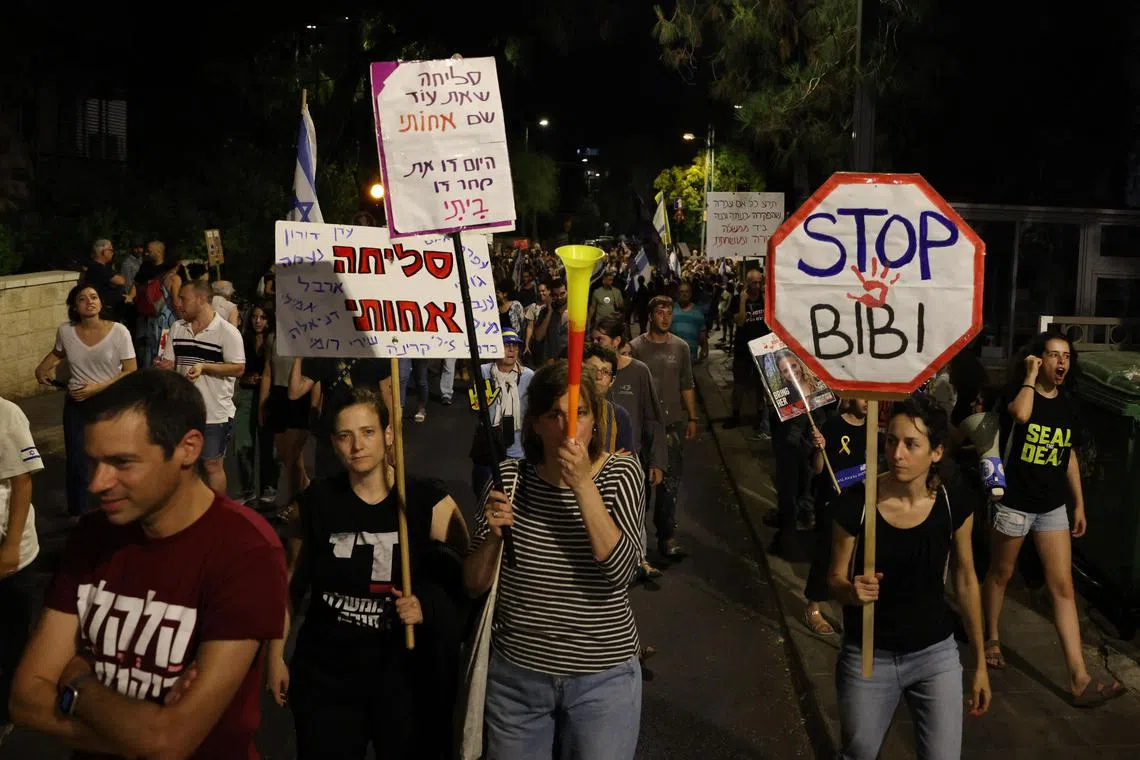Israel orders Palestinian residents to evacuate as tanks storm Gaza City districts
Sign up now: Get ST's newsletters delivered to your inbox

Smoke from an Israeli air strike seen in Gaza City on July 7, 2024.
PHOTO: REUTERS
Follow topic:
CAIRO – Israeli tanks advanced into the heart of Gaza City from different directions on July 8 and Israel ordered Palestinian civilians to evacuate neighbourhoods after a night of bombardments which the Gaza authorities said had killed dozens.
Residents said the air strikes and artillery barrages – which took place as multinational negotiations for a ceasefire deal intensified – were among the heaviest attacks on the Gaza Strip in nine months of conflict between Israeli forces and Hamas militants.
Gaza City, in the north of the Palestinian enclave, was one of the first areas that Israeli troops moved into at the start of the war. But fighting with militants still holding out there has persisted and civilians have sought shelter elsewhere, adding to multiple waves of displacement. Much of the city lies in ruins.
Residents said neighbourhoods in Gaza City had been bombed throughout the night into the early hours of the morning. Several multi-floor buildings have been destroyed, they added.
The Gaza Civil Emergency Service said it believed dozens of people were killed, but emergency teams were unable to reach them because of ongoing offensives in Daraj and Tuffah in the east and Tel Al-Hawa, Sabra and Rimal farther west.
Gaza residents said tanks advanced from at least three directions and reached the heart of Gaza City, backed by heavy Israeli fire from the air and ground. That forced thousands of people out of their homes to look for safer shelter, which for many was impossible to find, and some slept on the roadside.
One Israeli tank thrust pushed people towards the western road near the Mediterranean, residents said.
“The enemy is behind us and the sea is in front of us. Where will we go?” said Mr Abdel-Ghani, a Gaza City resident, who did not give his full name.
“Tank shells and missiles from the planes are falling on the roads and houses like hell from a volcano. People are running in all directions and no one knows where to go,” he told Reuters via a chat app.
The Israeli military said in a statement it was mounting an operation against militant infrastructure in the Gaza Strip, and that it has taken out of action more than 30 fighters who posed a threat to Israeli troops.

Protesters holding banners in a march on July 7 to call for a ceasefire and the release of Israelis held hostage by Palestinian militants in Gaza.
PHOTO: AFP
Later on July 8, it issued new evacuation orders to the residents of Sabra, Rimal, Tel Al-Hawa and Daraj districts.
“For your security, you must evacuate immediately to Deir al-Balah shelters in the humanitarian zone,” it said in a social media post, referring to an area in central Gaza.
The war was triggered on Oct 7 when fighters led by Hamas, which controlled Gaza, attacked southern Israel
More than 38,000 Palestinians have been killed in Israel’s military offensive, according to Gaza health officials.
Medics at the Al-Ahli Arab Baptist Hospital in Gaza City had to evacuate patients to the already crowded and under-equipped Indonesian Hospital in the northern Gaza Strip, Palestinian health officials said.
Israel’s military said it warned civilians about its operations, and that a route would be opened so civilians could evacuate from affected areas. It said fighters with Hamas and allied group Islamic Jihad were hiding behind civilian infrastructure to attack Israeli forces.
The Palestinian Fatah Al-Aqsa Martyrs Brigades said they fired mortar bombs against Israeli forces during the raid in south-west Gaza City.
Hopes for a pause
The new Israeli offensive comes as Egypt, Qatar and the United States stepped up efforts to mediate a ceasefire agreement between Israel and Hamas.
Hopes among Gaza residents of a pause in the fighting revived after Hamas accepted a key part of a US ceasefire proposal
Hamas has dropped a demand that Israel first commit to a permanent ceasefire before it would sign an agreement. Instead, the militant group said it would allow negotiations to achieve that throughout the six-week first phase, a Hamas source told Reuters on July 6.
But Israeli Prime Minister Benjamin Netanyahu insisted the deal must not prevent Israel from resuming fighting
Israeli Finance Minister Bezalel Smotrich said on July 8 it would be a huge mistake to stop the Israeli offensive now.
Mr Smotrich, who heads a pro-settler party which is part of Mr Netanyahu’s governing coalition, wrote on social media platform X: “Hamas is collapsing and begging for a ceasefire. This is the time to squeeze the neck until we crush and break the enemy. To stop now, just before the end, and let him recover and fight us again, is a senseless folly.”
Hamas said the new Israeli offensive in Gaza City will not succeed in breaking them.
“The arrogant enemy, which is practising the ugliest forms of aggression and violations against unarmed civilians, with absolute backing from the US administration, will not succeed in breaking our steadfast people regardless of how much it escalates its crimes,” the group said in a statement. REUTERS

